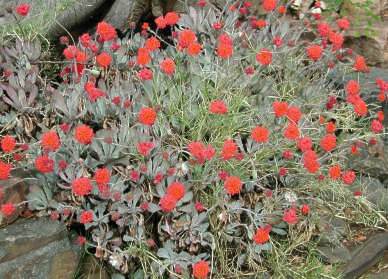Kleinia fulgens
Kleinia fulgens Hook.f.
Family: Asteraceae
Common names: coral senecio
Introduction
This is a stunning, grey-leafed plant with a profusion of scarlet flowers. It is ideal for hot, dry spots in the garden.
Description
Description

The plant grows to a height of about 600 mm and is ideal for planting in rockeries or other dry, sunny spots, as the scarlet flower heads add a splash of colour in mid-winter. The succulent leaves, which are an attractive grey/green with purpling on the underside, give the plant year-round appeal and add a pleasing contrast when planted amongst short grasses or spring flowering bulbs. The plant has a creeping, tuberous rootstock. Where it grows naturally, it is browsed by animals.

Distribution and habitat
Distribution description
The coral senecio occurs in hot, dry areas of KwaZulu-Natal, Mozambique and Zimbabwe.
Derivation of name and historical aspects
History
The genus is named after the German zoologist, Dr Klein (1685-1759). The species name, fulgens, means shining and refers to the vibrant, scarlet colour of the flowers.
Growing Kleinia fulgens
Grow
The plant can be propagated easily from seed, stem cuttings and leaf cuttings.
Seed: Sow fresh seed in seedtrays containing a very well-drained potting mixture such as 50% fine milled pine bark and 50% sharp sand. Cover the seed lightly and water carefully.

Stem cuttings: using a sharp knife, remove a section of mature stem. This can be rooted as is or it can be cut up into 15 mm sections. The pieces should be left to dry for 2 to 3 days before planting . The cuttings are then placed in a container of sharp river sand and kept in an airy, sunny position. Care must be taken not to over-water the cuttings-they are best kept on the dry side. Repot when sufficient roots have formed.
Leaf cuttings: mature leaves are removed from the parent plant using a sharp knife, allowed to dry for 2 to 3 days and planted in a container of sharp river sand. It is best to insert the leaf at an angle with about 1/3 in the rooting medium. Treat as for cuttings. It should take 6 to 8 weeks for a new plant to appear.
Credits
Brian Tarr
Natal National Botanical Garden
September 2002
Plant Attributes:
Plant Type: Succulent
SA Distribution: Gauteng, KwaZulu-Natal, Limpopo, Mpumalanga
Soil type: Loam
Flowering season: Autumn, Winter
PH: Acid, Alkaline
Flower colour: Red
Aspect: Full Sun, Morning Sun (Semi Shade), Afternoon Sun (Semi Shade)
Gardening skill:
Special Features:
Horticultural zones








Rate this article
Article well written and informative
Rate this plant
Is this an interesting plant?
Login to add your Comment
Back to topNot registered yet? Click here to register.